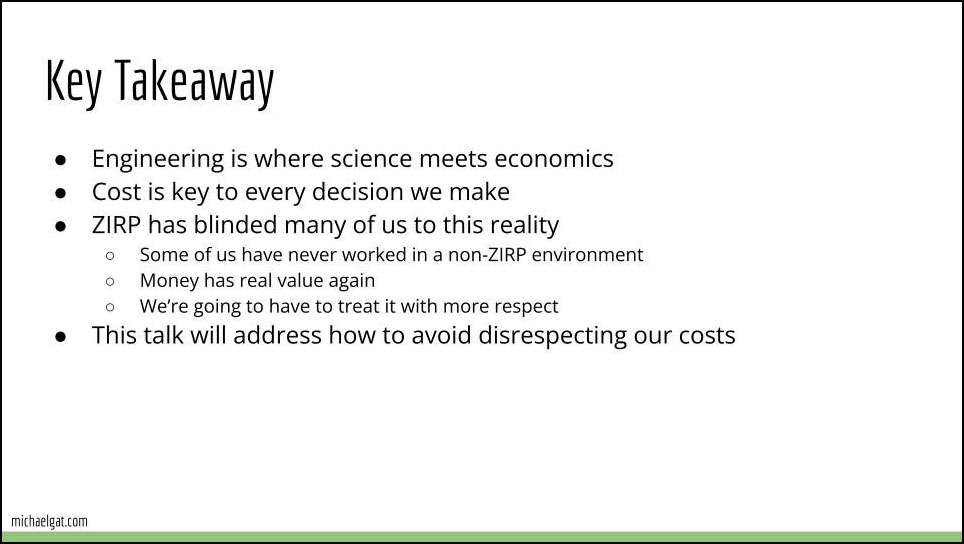Anti-Patterns in Tech Cost Management: Intro
Series Index
Introduction
Anti-Pattern 1: Not considering scale
Anti-Pattern 2: Bad cloud strategy
Anti-Pattern 3: Inability to assign/attribute costs
Anti-Pattern 4: No metrics or bad metrics
Anti-Pattern 5: Not designing it in
Anti-Pattern 6: Cost management as a standalone
Anti-Pattern 7/8: No ongoing reviews (current and potential)
Anti-Pattern 9: Across the board cuts
Anti-Pattern 10: “A tool will solve the problem!”
Anti-Pattern Bonus: Don’t do rewards programs!
A few thoughts: Three things you can do right now, for yourself and your team
Wrap up

On March 16, I’ll be presenting at the SoCal Linux Expo about technology cost management. Managing costs and efficiency is one of the things that has consistently run through my career in the past five years, from a role in managing capacity at AWS, to a brief role at Stripe where I was the program manager for efficiency, and then in my last role at AWS where I was the tech program manager for the billing compute, infrastructure and ops organization. In today’s tech environment, I thought it would be useful to focus in on some key anti-patterns I’ve seen in these roles, in my previous work managing AWS infrastructure as a consultant, and vicariously through my clients, colleagues and friends.
Today I’m publishing my intro slides with a few comments. Starting tomorrow, I’ll be putting up a brief post about each of the “Top 10” anti-patterns every day. The night before the talk, I’ll publish my “what you should do right now” recommendations. After the talk, I’ll write up my experience and any conclusions I can take away from the experience, including the things I’ll surely learn from my audience’s questions.
Intro
I’ll start with the “million monkeys” story. (Or as I tell it today, “million cats”). The point I’ll want to drive home is simple: it’s the business that matters, not so much the tech.
I’ll then dive into the focus of the talk: Cost is critical. I have often said that engineering is where science meets economics. In the tech world, this means that we as engineers are primarily concerned with using scientific and logical tools in order to achieve meaningful business results. We are not here to be researchers (though we sometimes need to research things) or to work on “pure knowledge” projects, though sometimes that’s the unintentional result. We’re not here to spend money in ways that a business cannot justify.
More than a decade of Zero Interest Rate Policy (ZIRP) has blinded many of us to that reality, as we’ve pursued dubious projects and “business” schemes. We’ve adopted technologies often without understanding the costs and benefits, and need to begin to respect the cost side more. This is a talk about how to avoid disrespecting our costs.
I’m going to focus on anti-patterns. Prescriptive advice is hard, generally needs to be tailored to the situation, and can’t be addressed well in a general purpose presentation. If you have a specific problem, I’m available to consult. Knowing anti-patterns helps avoid the major pitfalls that will cost you big over time and could end your business. In my experience in everything from investing, to tech management, to delivering backcountry emergency care, I have found that avoiding obvious mistakes gets you 50-80% there. If you survive to try again tomorrow, you can incrementally improve. My goal is to help you avoid the big mistakes that can prevent you from trying again.
There are some things that I just can’t address in the space allowed. I won’t talk about organizational or staffing issues, even though those are the largest budget item for many teams. I also won’t get into buy/build decisions. These are critical in many environments and worthy of an entire talk (or series of talks), but it’s not an appropriate focus for the SCaLE audience. For the same reason, I’m not going to talk about budget/forecasting, which is usually done by people with backgrounds in finance, not technologists.
Finally, I can’t talk about how to better manage the complex interplay between tech and business strategies, and how they impact costs. There’s a lot to cover there (if your CFO/CTO wants to hear about it, I will be happy to provide my rates), but it’s not right for this talk.

In discussing the anti-patterns I’m going to move from the strategic to the tactical. The patterns I’ll discuss are roughly organized in the order of potential negative impact. All impact us as tech practitioners, but we also have the ability to influence all of them. When it comes to cost, we need to understand how to “do it to them before they do it to us.” This will be a recurring theme.
The first anti-pattern will be published tomorrow: Not appreciating the impact of scale.
Join us at the SoCal Linux Expo (SCaLE 21x) in Pasadena on March 14-17. My talk will be on Saturday the 16th. I will also be speaking at UpSCaLE on Friday night, and running the Observability track on Saturday and Sunday.
It’s $90 for four days of great content. (If you know me, ping me as I may have a few discount passes left.)